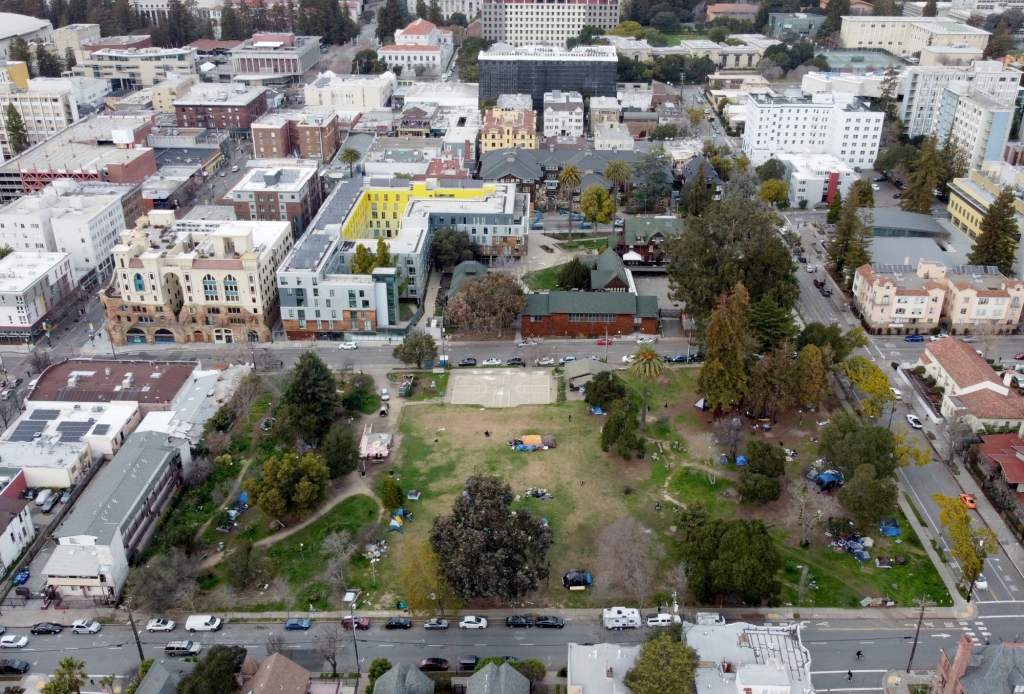BERKELEY — Half a century after the University of California’s proposal to build student dorms on a dirt lot triggered a history-making revolt, the university’s regents this week approved a student housing plan for the land now known worldwide as People’s Park.
The UC Board of Regents on Thursday approved spending $312 million to construct a 12-story and a six-story building to house 1,100 university students and 125 homeless people on 1.1 acres of the 2.8-acre park.
The other 1.7 acres would remain open space in honor of People’s Park’s colorful and occasionally tumultuous history.
A memo detailing the plan states construction is slated to begin in summer 2022 and that students could be living there by fall 2024.
But the project still faces a handful of legal challenges from labor and community groups that could delay it, as well as the remnants of a resistance movement that promises to protest every step of the way.
Community groups Make UC A Good Neighbor and People’s Park Historic District Advocacy Group sued the university in August, arguing that its “long range development plan” violates state environmental laws and will displace longtime residents, destroy neighborhood character and drain city emergency services such as police and fire.
“UC’s plans are a reflection of the university’s indifference to the impact its plans will have on all Berkeley residents for many years to come,” Harvey Smith of the People’s Park Historic District Advocacy Group said during an August announcement of the lawsuits’ filing. “UC’s corporate growth model monetizes public assets with little care given to its host community.”
Some speakers at the regents’ committee meeting prior to the full board’s vote promised to continue resisting the school’s housing project.
Despite the pushback and the fabled history of People’s Park, university officials and city leaders have hailed the project as an opportunity to provide desperately needed housing for students forced to live far away from the university because of Berkeley’s steep rents.
In addition, the housing will accommodate more than 100 currently homeless people who will be able to get support and services from a nonprofit that’ll manage the site.
The university houses about 23% of its students — a lower rate than other UC schools, Berkeley Chancellor Carol Christ told the regents committee Wednesday. This year, the school turned away 5,000 students from student housing.
“I think this is the most critical problem Berkeley is facing,” Christ said. “Berkeley is a land-constrained campus, and we have to use every piece of land we have in order to meet our goals for student housing.”
But Christ also acknowledged the concerns of activists and residents in the area who fear the displacement of people who currently sleep and hang out in People’s Park. She promised construction would not begin until the university can find housing for the 40 to 45 unhoused people who sleep there.
“Even as work continues to ensure their needs will be met once the park is temporarily closed for construction, our full-time social worker is in People’s Park every day, helping to connect those in need with the services and support they require,” Christ wrote in a message to the campus community Thursday about the project approval. “To date, he has found permanent housing for more than 80 unhoused people.”
But such assurances have not persuaded those who want to preserve the history of People’s Park, whose existence as a center of protest sprung from the university’s original plan in 1968 to build student housing.
Throughout the 1950s and 1960s the university bought up lots for student housing and in 1968 razed homes on a 2.8-acre plot just east of Telegraph Avenue that would become People’s Park.
While waiting for the money to come through to pay for the housing, People’s Park became a hub for students and activists who would go on to protest everything from the university’s housing plan to the raging Vietnam War.
In May 1969, protesters tore down a fence the university had put up to keep people out of the park, resulting in a violent clash that saw protesters throwing rocks at the hundreds of riot-gear-clad police officers guarding the park
Police responded with gunfire, and one of the bullets struck and killed 25-year-old student James Rector, of San Jose, who was watching from a rooftop.
According to media reports at the time, many protesters were hospitalized — some with bullet wounds — one police officer was stabbed and three others injured from the rocks and glass.
Over the years, the university made a few attempts to take back the park but was thwarted and backed off — until 2018, when it announced its current plan.
Although the announcement set off some scattered protests that at one point resulted in demonstrators tearing down a fence the university had erected around the park — reminiscent of the scene several decades earlier when the National Guard was summoned — the regents approved the latest plan.
Only student regent Alexis Atsilvsgi Zaragoza, a UC Berkeley undergraduate, voted against it.
In her message to the campus, Christ acknowledged that the move is still controversial today.
“While I am appreciative of the support we have gained, I know we have work to do to build awareness, understanding and support among those who remain skeptical,” she wrote. “I look forward to continued, meaningful engagement with every part of our community, supporters and opponents alike.”










